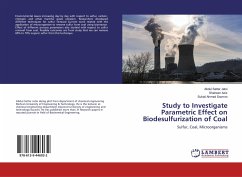Coal liquefaction was usually carried out at temperature higher than 400°C and at relatively high pressure. Many attempts have been made to develop methods of dissolving coal at less severe conditions in order to increase coal liquefaction efficiency and also to reduce capital and operation cost. In this investigation, three different types of pretreatments i.e. solvent swelling, in-situ solvent soaking and heating, and microwave irradiation have successfully been applied to untreated low rank Malaysian coal prior to liquefaction. The main objective of the pretreatments is to further enhance coal conversion and oil yield at less severe liquefaction conditions and this was successfully achieved for all the applied pretreated coals. A good coal-to-solvent contact and weakened coal structure were found to be equally important factors in determining high coal conversion and oil yield obtained during liquefaction.
Bitte wählen Sie Ihr Anliegen aus.
Rechnungen
Retourenschein anfordern
Bestellstatus
Storno








